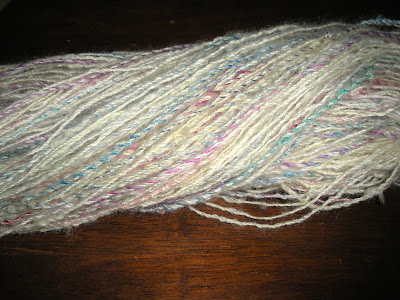 |
| I'm calling this "Cotton Candy Confetti Yarn" |
I don't have a project in mind for it yet, but I thought I would share some tips on measuring and documenting spinning projects - and mystery items in the stash that have lost their labels.
First, the platform. A lot of people tie samples of their handspun to index cards, or tape them in notebooks. The advantage of this is that you get to look back at your yarn with all five senses if you want (not sure why you would want to taste your yarn, but you could). I use Ravelry to keep track of my projects, because I find that a lot easier, but it would be nice if I could feel the softness or tension of the yarn that I made.
That said, if you don't have a sample with your description, a picture is pretty crucial. I spend a lot of time on my computer adjusting the colors of my photos to try to make it look close to how the yarn actually looks. You may have noticed that I often include a coin in my pictures, to give a sense of scale, as well.
After you have a picture or a sample, the next thing to include in your documentation is your fiber source. If you are dealing with handspun on Ravelry, you can link directly to a fiber page, hopefully with pictures and details on breed or fiber-mix. On a physical sample card, you can include a small sample of the fiber along with the yarn. Be as detailed as you can about what state the fiber was in when you got it (in the grease? mill-carded into roving?) and as much as you know about the animal it came from. If it is mystery fiber, you can always try a burn test, though the results are not that useful for blends.
I unfortunately didn't record much info about the colored locks in the cotton-candy yarn: I know they were a soft longwool or mohair, and I bought them as dyed locks - I don't even know from which booth at MD S&W. But, since that is what I have, that is what I recorded.
 |
| Assorted dyed locks - unknown breed |
 |
| Undyed, washed, Lincoln-Crossbreed locks; from Barnswallow Fibers and Yarns. |
First, weigh it. I general record in ounces because the fiber is sold that way in the US, but the units don't matter, as long as you indicate which ones you used - 4 ounces is very different from 4 grams.
 |
| 4.75 ounces of yarn |
Next, you want the amount of yarn in length. Always check this after you have wet-finished the yarn, as that may shrink it a bit. Stretch out your skein and use measuring tape to get the length of one round, count the rounds, and multiply.
 |
| Always re-measure the skein after washing, even if you know the length of your niddy-noddy. |
Finally, I calculate the "weight" or width of the yarn, in wraps per inch (WPI). This is not super-accurate, because different people wrap loosely or tightly, but the idea is that you wrap your yarn around a ruler and see how many "wraps" there are to the inch. The yarn shouldn't be stretched, and it shouldn't be packed in too much either.
 |
| 13 WPI |
Unfortunately, I haven't seen a lot of agreement matching WPI to weight. Depending on the source, 13 WPI is either a heavy fingering or DK.
Although I don't, twist angle is another possible measurement - just use a protractor.




No comments:
Post a Comment